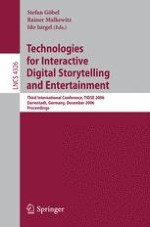This textbook contains the proceedings from the 3rd International Conference on Technologies for Interactive Digital Storytelling and Entertainment (TIDSE 2006). The contributions are grouped into six sections, which include subjects like virtual characters, story authoring, narrative systems, and examples of their application. During recent years, Interactive Digital Storytelling has evolved as a prospering - search topic, banding together formerly disjoined disciplines stemming from the arts and humanities as well as computer science. The subject of this book is of course strongly related to the notion of ‘storytelling’, which has been used as an effective means for the communication of knowledge and social values, ever since the early history of humankind. It also tries to build a bridge between current academic trends, for example, by investigating and formalizing narrative aspects of computer games, and by its developments for the experience-based design of human–media interaction in general. Starting with a scientific workshop at national level in 2000, the Digital Sto- telling group at ZGDV Darmstadt originated TIDSE, the International Conference for Technologies in Interactive Digital Storytelling and Entertainment. TIDSE 2003, TIDSE 2004, and TIDSE 2006 continued this series, and provided the latest research outcomes and indications for its usage within entertainment applications.
